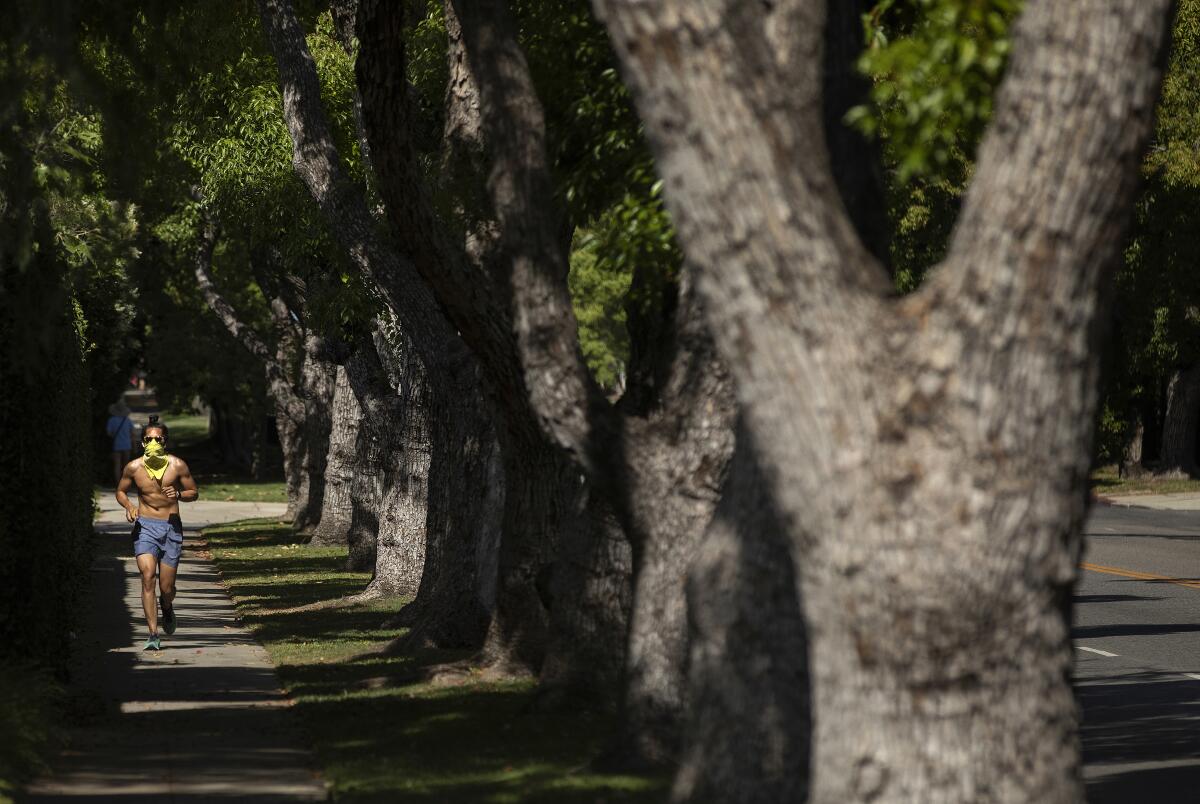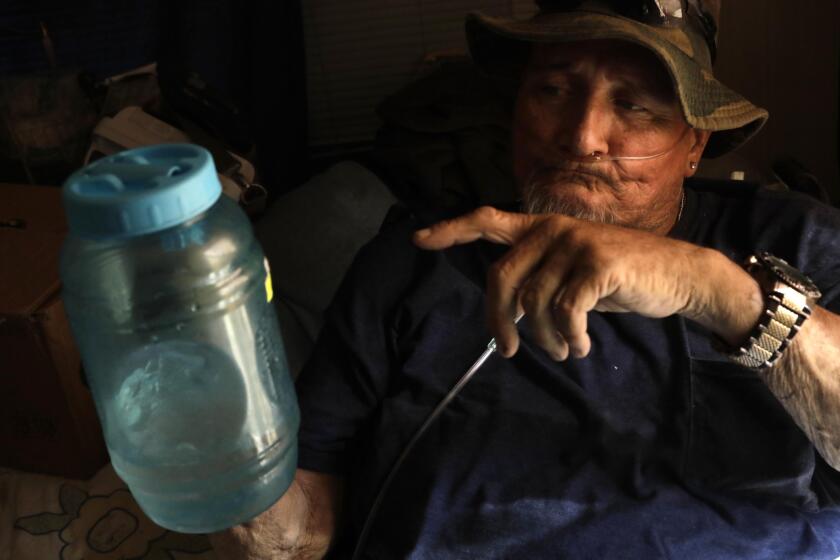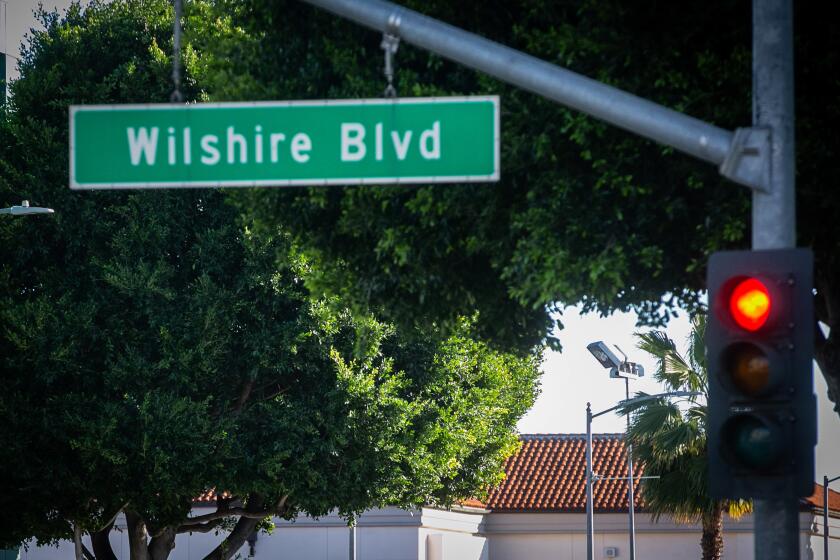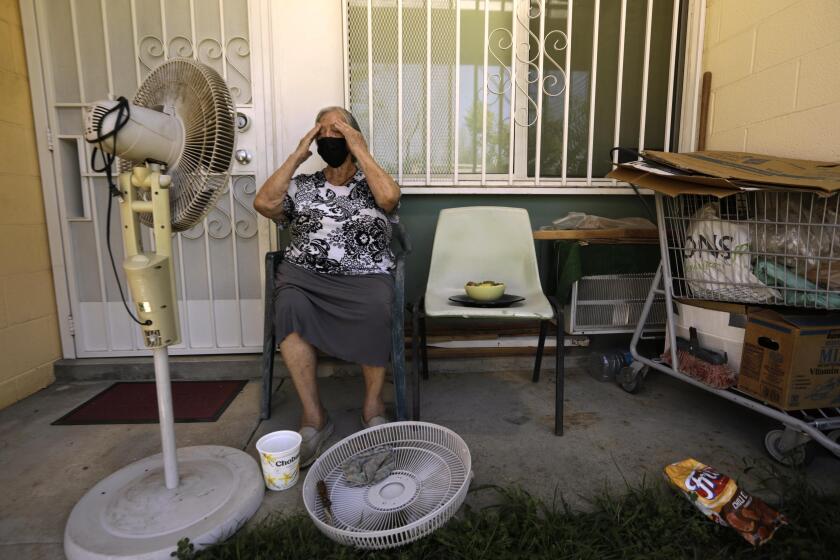L.A. wanted to cut down 12,000 trees. Advocates stood in the way

- Share via
More than 12,000 mature trees in Los Angeles may be spared the ax after advocates of tree preservation prevailed in court.
The recent decision by a Los Angeles Superior Court judge found that city leaders had failed to adequately consider the cumulative effects of removing thousands of trees along city streets during its 30-year sidewalk revamp project. The judge has effectively blocked further tree removal until the issue is remedied.
Celebrating their victory, plaintiffs are hopeful the city will work to find solutions that preserve such trees, especially as the plants become increasingly important in the face of more frequent and more extreme heat.
“Our goal is for them to consider the benefits of trees and all of the eco-services that they provide — they clean the air, they’re cooling, they provide biodiversity — and treat [them] as green infrastructure,” said Jeanne McConnell, co-founder of Angelenos for Trees. “The city continues to remove a lot of trees, in the hundreds and thousands each year, and the tree canopy is actively declining.”
In their lawsuit, McConnell’s organization, along with the nonprofit United Neighborhoods for Los Angeles, alleged that city officials improperly moved forward with its $1.3-billion sidewalk project without adhering to requirements in the California Environmental Quality Act — failing to consider the short-term effect of removing so many trees, the effect on non-sensitive bird species and the cumulative impact, especially given other ongoing projects in the city that are also removing trees.
That state law requires organizations across California to identify potentially significant environmental impacts of a project, then find ways to avoid or mitigate those impacts, when possible.
“This is a really significant win for environmentalists in the city of Los Angeles, and the general public,” said Jamie T. Hall, co-counsel in the lawsuit and self-proclaimed tree lover. “The city wanted to value efficiency and streamlining. ... That comes at environmental costs.”
The city, in court filings, denied the allegations and stood by its environmental impact report for the project.
Read all of our coverage about how California is neglecting the climate threat posed by extreme heat.
But Los Angeles Superior Court Judge Mitchell Beckloff sided with the tree advocates, ruling that environmental report was no longer valid.
“The court finds the city failed to proceed as required by law when it omitted sufficient analysis of the project’s impacts on non-sensitive status species,” Beckloff wrote in the Jan. 17 decision. He called the environmental analysis “deficient” in its review of the project’s “cumulative effects.”
Hall and co-counsel Sabrina Venskus are hopeful this decision will lead to a new environmental evaluation of the project, including a more thorough review of alternatives for repairing sidewalks while preserving mature trees. But he said it was unclear how the city would proceed, as city attorneys could choose to appeal the ruling.
“The City is reviewing and considering its options for responding to the trial court’s ruling,” Ian Thompson, a spokesperson for City Atty. Hydee Feldstein Soto, said in a statement. He declined to comment further.
For the record:
9:51 p.m. Feb. 14, 2023An earlier version of this article referred to the Los Angeles city attorney as Hydee Feldstein. Her last name is Feldstein Soto.
Venskus said the city created a “false choice” between saving mature trees and fixing sidewalks, but she said both were important and not mutually exclusive. The project to repair the city’s sidewalks was initially implemented in a 2016 settlement after an Americans With Disabilities Act lawsuit, and Venskus said the plaintiffs in the suit supported the repairs — just within parameters that would better preserve trees.
“Other cities can preserve their mature street trees and sidewalks. I think L.A. can too,” Venskus said. “They have to rise to that challenge because if they don’t, they’re not going to be able to achieve their goals of being a climate-resilient city.”
McConnell pointed to other cities such as Portland, Ore., Pasadena and Ojai that had preserved trees while maintaining sidewalks. She said she’d like to see Los Angeles look into alternatives to removing trees that interfere with sidewalks, such as meandering sidewalks that go around the trees; using permeable pavement that wouldn’t buckle from the roots; or bumping out sidewalks into streets.
As of fall 2022, the Sidewalk Repair Project had reported removing almost 850 trees, while having planted nearly 1,700 new trees, according to records from an October update from the city’s Bureau of Street Services. McConnell said those counts didn’t consider other developments or construction projects where trees had been removed.
Some 87 ficus trees on Robertson Boulevard will be cut down for a sidewalk project. For some, the removals are bittersweet. For others, they feel like a death.
“It does take time and conversation, but it’s worth it because you could potentially save a mature tree that provides a host of environmental benefits,” Hall said. “It’s always going to be easier to cut down the trees.”
Preserving trees in L.A. has been a longtime issue for climate activists, as trees continue to be an important line of defense against warming temperatures. In Beverly Hills, a fight to save ficus trees is ongoing, with the trees also set for removal to make room for sidewalks. And there’s a similar project and battle underway in Long Beach.
Research has shown the city’s tree canopy is unevenly distributed and can create a heat island effect — areas with less shade and tree cover can be significantly warmer than those with tree canopy.
Paved surfaces, tree cover, and home construction quality can make the difference between heat waves being an inconvenience or a threat to your life.
In South L.A., where there are fewer trees on private property, it means “street trees play an outsize role” in the community, Hall said, making their preservation an “environmental justice issue as well.”
Hall and his team hope that with the city’s new administration as well as a new chief heat officer, officials will be more receptive to these issues. In an already positive sign, City Councilmember John Lee on Tuesday introduced a motion that would direct city agencies focused on the urban forest to find “sustainable solutions” for sidewalk repairs that “preserve the city’s mature street trees while ensuring safe sidewalks” — the compromise the tree activists wanted to see. The motion, if passed, would also look for new opportunities to fund such projects.
“This will be an opportunity for the city to really look at the impacts of taking out street trees ... and seeing the value in investing resources and maintaining our trees, no matter what the projects may be,” Venskus said. “We need to find a balance.”
More to Read
Sign up for Essential California
The most important California stories and recommendations in your inbox every morning.
You may occasionally receive promotional content from the Los Angeles Times.














